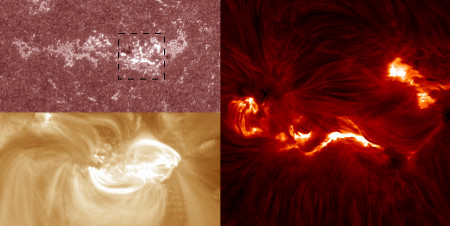
C-Class flare from 08-Jul-2011. SDO/AIA images 1700Å (top), 193Å (bottom) from NASA, HARDcam H-alpha image (right) courtesy of David Jess.
Solar flares are impulsive releases of energy in the Sun’s corona and yet it is emission from the lower atmosphere (the photosphere and chromosphere) that contains the bulk of the energy. This radiation also provides some of the best diagnostics of the flaring process. The availability of optical, UV/EUV and hard X-ray observations, made with the current fleet of space-based (SDO, Hinode, RHESSI, etc.) and ground-based (ROSA, IBIS, Big Bear, etc.) observatories, combined with recent developments in flare modelling, presents a timely opportunity to study the cause and effect of energy deposition in the lower solar atmosphere. The combination of multi-wavelength observations with advanced numerical simulations can provide key insights into the processes of particle acceleration, plasma heating, energy transport, and wave propagation.
This Royal Astronomical Society discussion meeting will focus on work investigating the response of the lower solar and stellar atmospheres during a flare’s impulsive phase and we welcome contributions from both observation and theory.
Registration Deadline: Passed for talks
Only registrations and poster abstracts can now be submitted. Registration page
When & Where:
Friday, 12th April 2013, 10:30-15:30, followed by the Monthly A&G Meeting. RAS, Burlington House, London, UK.
Organisers: Iain Hannah (University of Glasgow) and Ryan Milligan (Queen’s University Belfast).